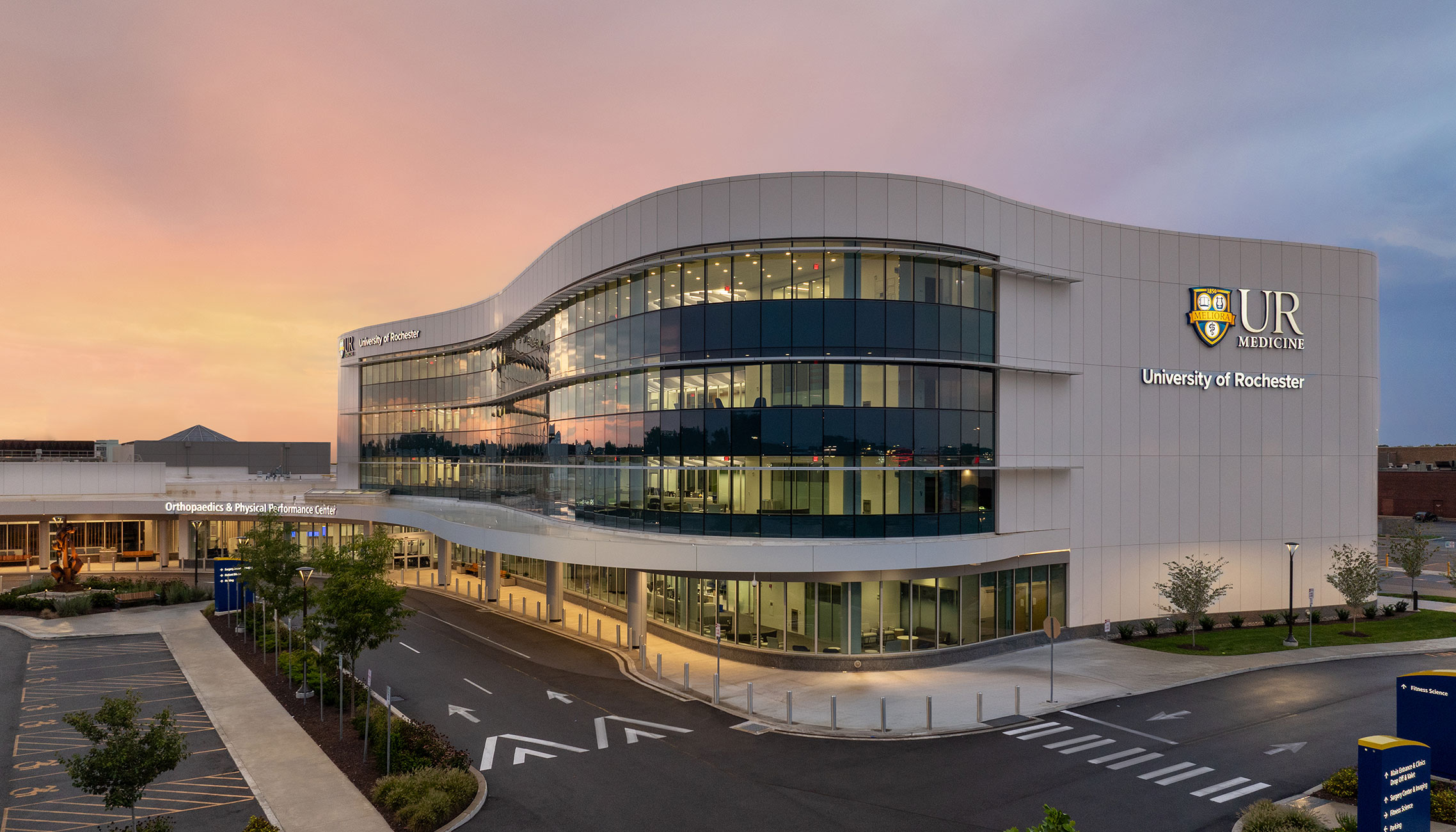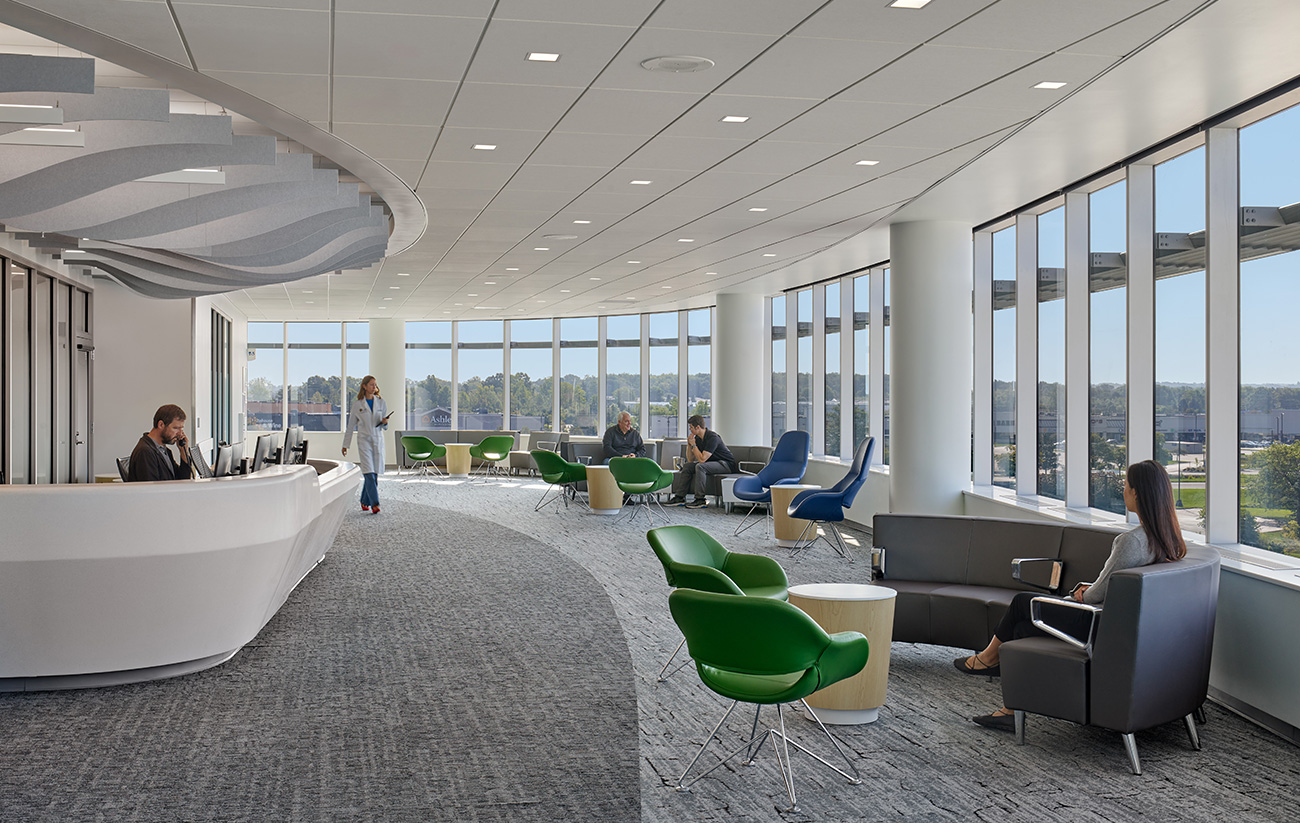HENRIETTA, NY, November 12, 2024 – Shopping center visitors and residents in Henrietta, New York can now see an unexpected name next to the usual department stores and national chains: the University of Rochester Medical Center (URMC). In 2023, URMC opened the Saunders Center for Orthopaedics and Physical Performance in the Marketplace Mall, on the site of a former Sears.

One of the largest outpatient orthopaedics facilities in the Northeast, The Center is a collaboration between architect of record SLAM (The S/L/A/M Collaborative) and design architect Perkins&Will. Its design and siting reflect a convergence of available retail spaces driven by the surge in e-commerce, the evolution of outpatient orthopaedic care, and a growing national demand for more convenient healthcare infrastructure.
“With healthcare facilities nationwide shifting towards decentralized services, repurposing underutilized retail spaces offers a tremendous opportunity for institutions like URMC to expand their outpatient services by relocating to mall settings,” says Scott Hansche, AIA, principal-in-charge at SLAM.
The 372,400 square-foot facility includes a 227,000 square-foot renovation and a 145,400 square-foot new outpatient clinical services building housing ambulatory surgery and post-operative care, 144 exam rooms, advanced diagnostic imaging, movement-based physical therapy and athletic training, computerized motion analysis, customized prosthetics and assistive devices, and injury risk assessment and prevention.
Community Care Close to Home
The Orthopaedics & Physical Performance Center reflects an urgency to expand infrastructure into underserved regions, helping to address the country’s healthcare equity gaps. One of the design team’s priorities for the new facility was to create a sense of familiarity and accessibility.
“Repurposing a traditional community anchor, such as a mall, helps upend perceptions of healthcare as a centralized urban complex,” says Robert Goodwin, FAIA, design principal for the project based in Perkins&Will’s New York studio. “We are integrating healthcare into the existing fabric of the community rather than asking patients to travel to a facility that might be hard to reach or seem intimidating in scale or layout.”
The focus on accessibility is evident in a series of decentralized entry points and the addition of a dedicated bus stop outside of the outpatient facility along the mall’s usual route. Ample parking and public transit access ensure equity for all members of the community, as well as those visiting from farther away. Entrances are clearly marked, and generous interior waiting areas and valet parking provide protection from the inclement weather and cold temperatures of upstate New York winters.

“The Saunders Center for Orthopaedics and Physical Performance has been tremendously well-received by patients,” says Dr. Paul Rubery, the Chair of Orthopaedics at URMC. “The location is known to most people in the region, and its previous role as a retail site means that accessibility is tremendous. The design principles employed were focused on patients with mobility challenges and I consistently hear from patients how much more manageable this facility is for them than our previous office locations.”
Anticipating the Future of Orthopaedics
As technological improvements and medical advances allow for shorter recovery times following surgical procedures, orthopaedics has moved beyond inpatient treatment to a relatively quick outpatient experience and lifelong-care model. In the months since the Saunders Center opened, URMC has seen a continuous uptick in demand for all services offered at the location.
“The layout and design of the Sunders Center reflect the changing demands of orthopedic care,” says Carolyn BaRoss, interior design principal at Perkins&Will. “Patients conveniently access the full spectrum of care with ease, in an encouraging and comfortable environment that encourages mobility. We were inspired by an early statement by Dr. Rubery, that in winter in Rochester, caregivers arrive before sunrise and leave after dark, so we planned daylight access into the new tower’s clinic modules. Additionally, we took full advantage of the existing mall building which offered not only tall ceilings, but also skylights which were repurposed and supplemented to provide abundant daylight in Pre and Post OP, therapy spaces, rehabilitation gyms and pools.”

Anticipating patients back on their feet sooner, much of the renovated portion of the project houses physical therapy and recovery areas, and sports performance facilities. One such area, the CHAMPP Gym (Center for Human Athleticism and Musculoskeletal Performance and Prevention), is dedicated to injury prevention, athletic performance training, nutrition, and academic support for student athletes.
“The facility has been an enormous benefit to patients, faculty and staff; the increase in space, the thoughtful design, and the transmission of natural light inside has improved our collective wellness,” says Dr. Rubery. “With the larger footprint, we have been able to introduce novel programs for patients such as our osteoporosis nutrition classes and our group exercise programs. We have seen steady growth in visits and procedures, and yet have not experienced crowding, lines or pressured spaces.”
A Rapid and Resilient Solution to the Healthcare Supply Chain
Breathing a second life into an expansive yet under-utilized retail complex yields both economic and environmental benefits, allowing the design team to repurpose existing infrastructure and resources while reducing costs and construction times.
“Construction began in June 2021, and by 2023, the transformed space was up and running—a swift turnaround that benefits both our team and URMC. With existing infrastructure, we could concentrate on realizing the university’s vision for a facility that integrates orthopaedics, radiology, surgery, and treatment under one roof, meeting the region’s growing demand for accessible care,” says Hansche.
The “medtail” model has been explored elsewhere in the United States to similar effect, proving that while the retail landscape may be changing, the convenience of the suburban strip mall remains appealing to patients as well as to hospital systems seeking a relatively fast and affordable way to keep up with demand.
